HMG7230: Analysis of Global Food Systems and Security in Australia
VerifiedAdded on 2022/10/01
|19
|5001
|204
Report
AI Summary
This report provides a comprehensive analysis of the global food system in Australia, examining various aspects including food utilization, consumption patterns, internal and external access to food, and food availability. It explores the influence of globalization, regional disparities, and socioeconomic factors on food security, highlighting the role of government policies, non-profit organizations, and the agricultural sector. The report also investigates the vulnerability of the Australian food system to climate change, emphasizing the risks associated with rising temperatures, altered rainfall patterns, and natural disasters. Furthermore, it identifies key resources, supporting policies, and organizations involved in the food system, while also discussing the country's import and export dynamics. The report concludes by emphasizing the need for addressing food insecurity and strengthening resilience within the Australian food system, especially considering the impact of climate change.
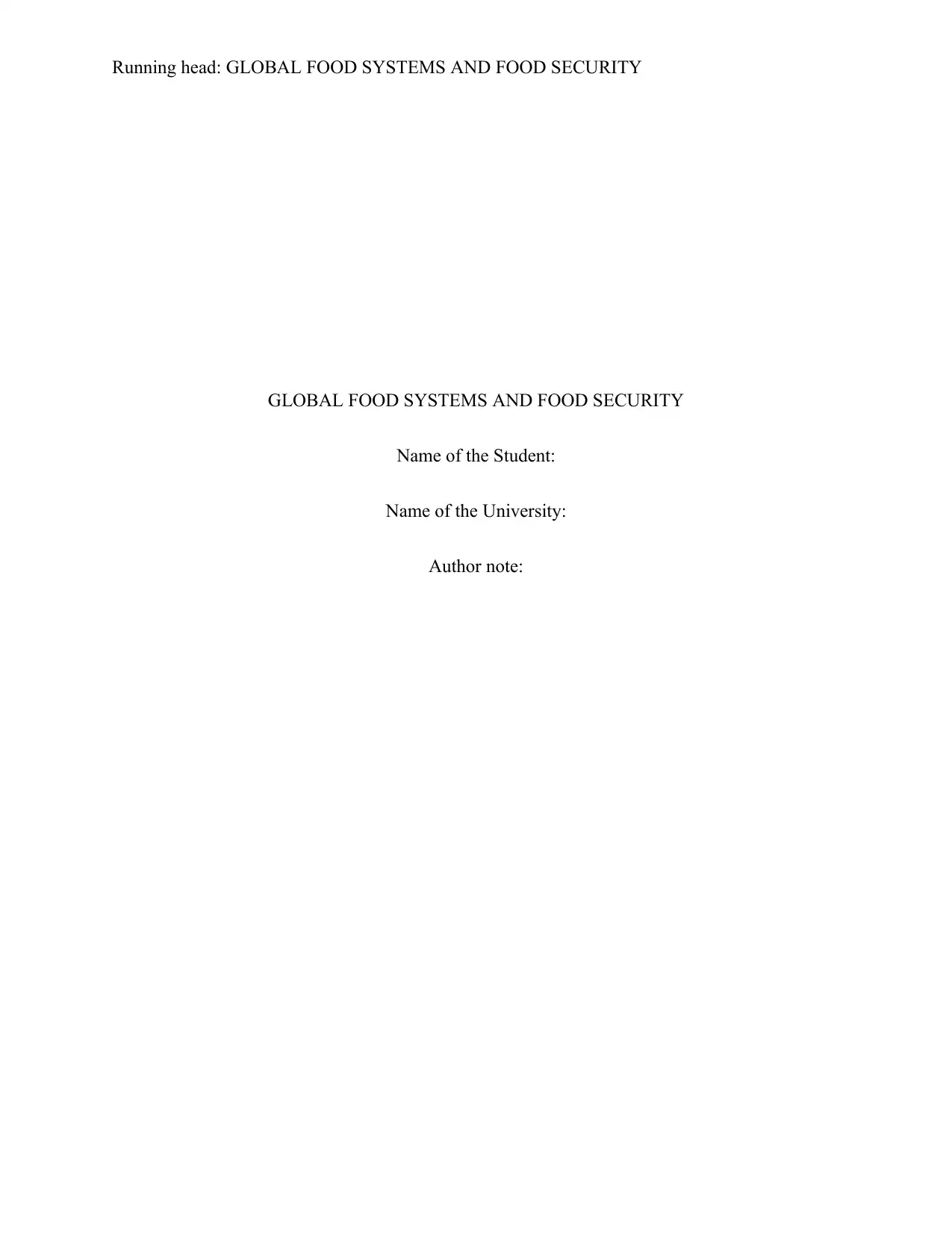
Running head: GLOBAL FOOD SYSTEMS AND FOOD SECURITY
GLOBAL FOOD SYSTEMS AND FOOD SECURITY
Name of the Student:
Name of the University:
Author note:
GLOBAL FOOD SYSTEMS AND FOOD SECURITY
Name of the Student:
Name of the University:
Author note:
Paraphrase This Document
Need a fresh take? Get an instant paraphrase of this document with our AI Paraphraser
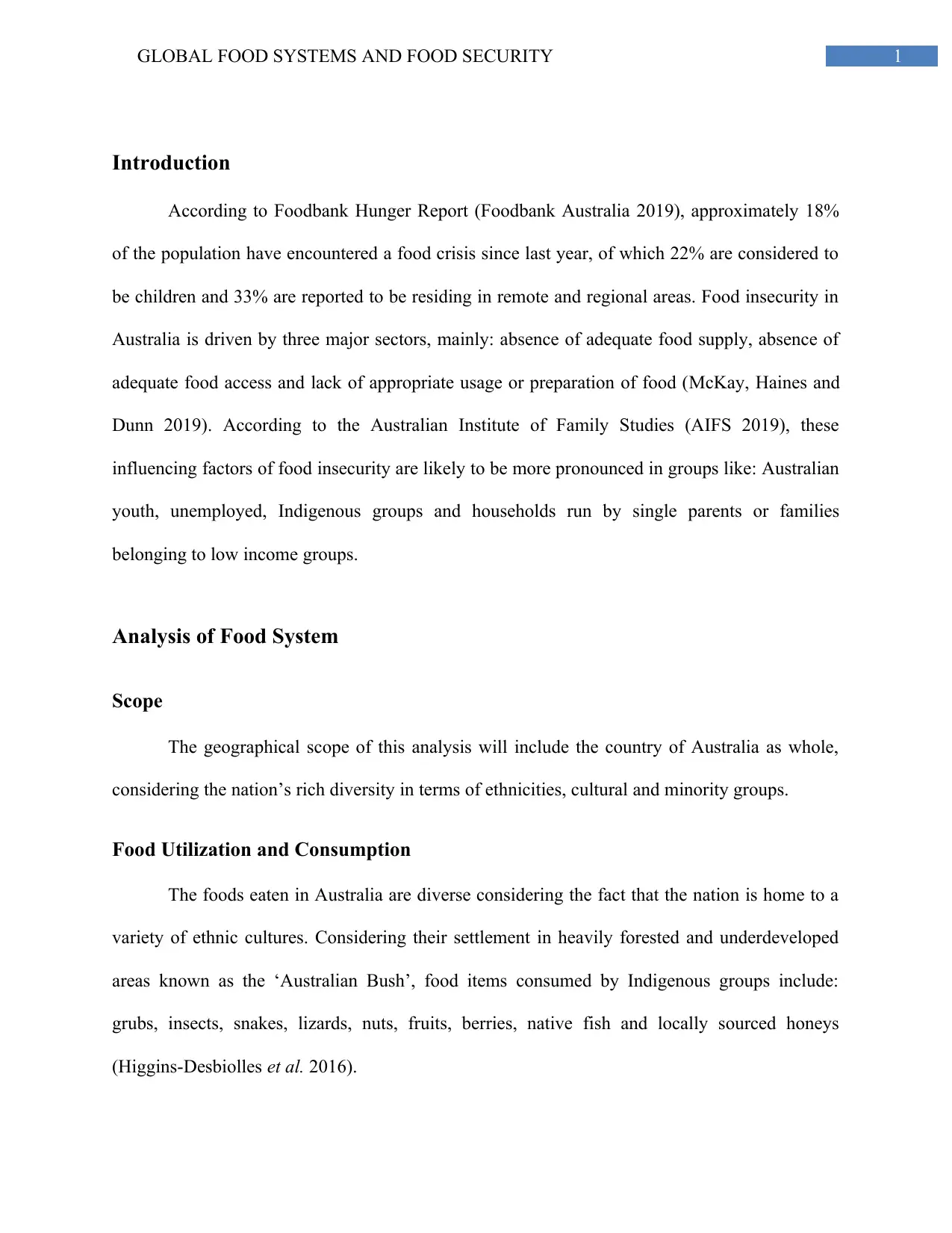
1GLOBAL FOOD SYSTEMS AND FOOD SECURITY
Introduction
According to Foodbank Hunger Report (Foodbank Australia 2019), approximately 18%
of the population have encountered a food crisis since last year, of which 22% are considered to
be children and 33% are reported to be residing in remote and regional areas. Food insecurity in
Australia is driven by three major sectors, mainly: absence of adequate food supply, absence of
adequate food access and lack of appropriate usage or preparation of food (McKay, Haines and
Dunn 2019). According to the Australian Institute of Family Studies (AIFS 2019), these
influencing factors of food insecurity are likely to be more pronounced in groups like: Australian
youth, unemployed, Indigenous groups and households run by single parents or families
belonging to low income groups.
Analysis of Food System
Scope
The geographical scope of this analysis will include the country of Australia as whole,
considering the nation’s rich diversity in terms of ethnicities, cultural and minority groups.
Food Utilization and Consumption
The foods eaten in Australia are diverse considering the fact that the nation is home to a
variety of ethnic cultures. Considering their settlement in heavily forested and underdeveloped
areas known as the ‘Australian Bush’, food items consumed by Indigenous groups include:
grubs, insects, snakes, lizards, nuts, fruits, berries, native fish and locally sourced honeys
(Higgins-Desbiolles et al. 2016).
Introduction
According to Foodbank Hunger Report (Foodbank Australia 2019), approximately 18%
of the population have encountered a food crisis since last year, of which 22% are considered to
be children and 33% are reported to be residing in remote and regional areas. Food insecurity in
Australia is driven by three major sectors, mainly: absence of adequate food supply, absence of
adequate food access and lack of appropriate usage or preparation of food (McKay, Haines and
Dunn 2019). According to the Australian Institute of Family Studies (AIFS 2019), these
influencing factors of food insecurity are likely to be more pronounced in groups like: Australian
youth, unemployed, Indigenous groups and households run by single parents or families
belonging to low income groups.
Analysis of Food System
Scope
The geographical scope of this analysis will include the country of Australia as whole,
considering the nation’s rich diversity in terms of ethnicities, cultural and minority groups.
Food Utilization and Consumption
The foods eaten in Australia are diverse considering the fact that the nation is home to a
variety of ethnic cultures. Considering their settlement in heavily forested and underdeveloped
areas known as the ‘Australian Bush’, food items consumed by Indigenous groups include:
grubs, insects, snakes, lizards, nuts, fruits, berries, native fish and locally sourced honeys
(Higgins-Desbiolles et al. 2016).
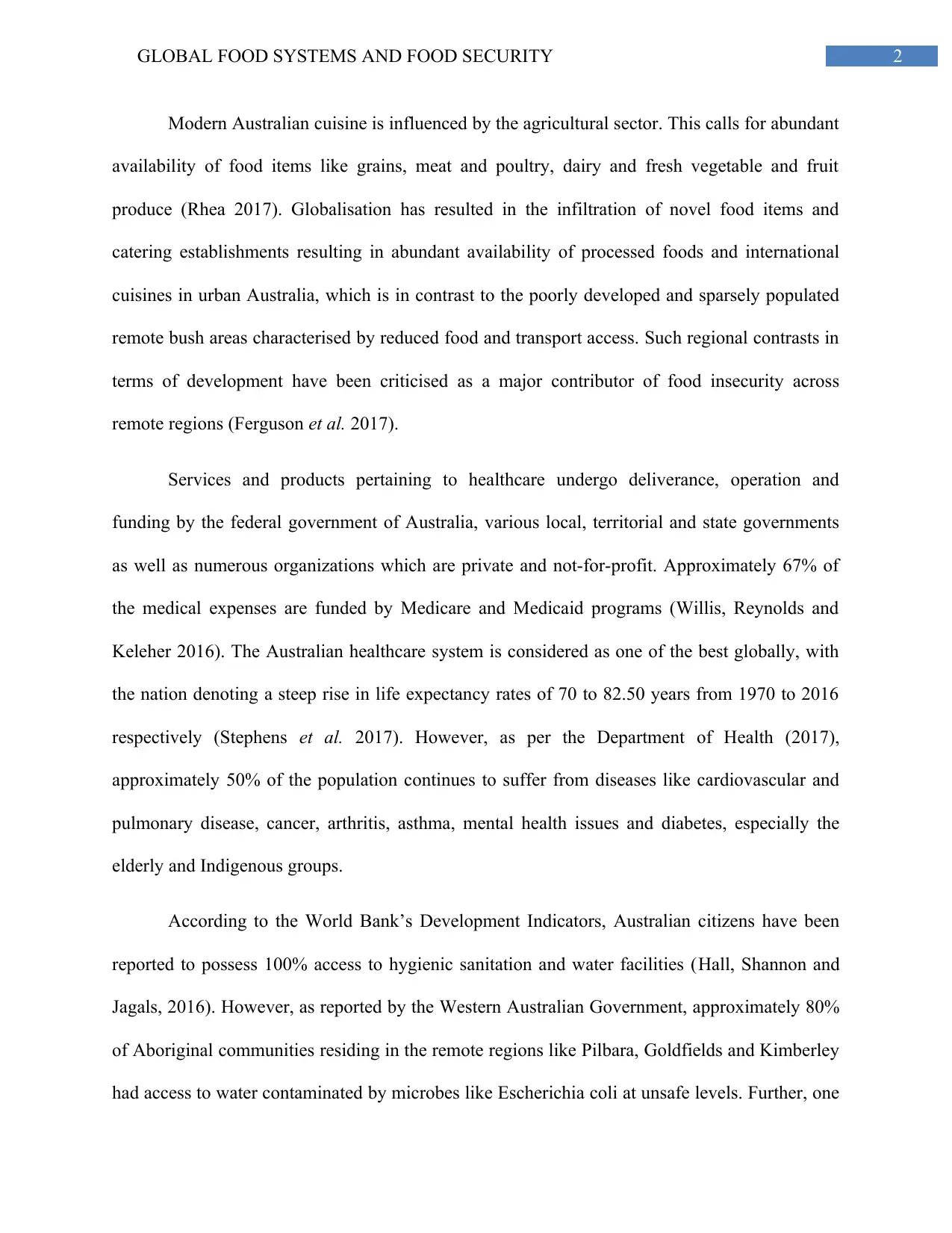
2GLOBAL FOOD SYSTEMS AND FOOD SECURITY
Modern Australian cuisine is influenced by the agricultural sector. This calls for abundant
availability of food items like grains, meat and poultry, dairy and fresh vegetable and fruit
produce (Rhea 2017). Globalisation has resulted in the infiltration of novel food items and
catering establishments resulting in abundant availability of processed foods and international
cuisines in urban Australia, which is in contrast to the poorly developed and sparsely populated
remote bush areas characterised by reduced food and transport access. Such regional contrasts in
terms of development have been criticised as a major contributor of food insecurity across
remote regions (Ferguson et al. 2017).
Services and products pertaining to healthcare undergo deliverance, operation and
funding by the federal government of Australia, various local, territorial and state governments
as well as numerous organizations which are private and not-for-profit. Approximately 67% of
the medical expenses are funded by Medicare and Medicaid programs (Willis, Reynolds and
Keleher 2016). The Australian healthcare system is considered as one of the best globally, with
the nation denoting a steep rise in life expectancy rates of 70 to 82.50 years from 1970 to 2016
respectively (Stephens et al. 2017). However, as per the Department of Health (2017),
approximately 50% of the population continues to suffer from diseases like cardiovascular and
pulmonary disease, cancer, arthritis, asthma, mental health issues and diabetes, especially the
elderly and Indigenous groups.
According to the World Bank’s Development Indicators, Australian citizens have been
reported to possess 100% access to hygienic sanitation and water facilities (Hall, Shannon and
Jagals, 2016). However, as reported by the Western Australian Government, approximately 80%
of Aboriginal communities residing in the remote regions like Pilbara, Goldfields and Kimberley
had access to water contaminated by microbes like Escherichia coli at unsafe levels. Further, one
Modern Australian cuisine is influenced by the agricultural sector. This calls for abundant
availability of food items like grains, meat and poultry, dairy and fresh vegetable and fruit
produce (Rhea 2017). Globalisation has resulted in the infiltration of novel food items and
catering establishments resulting in abundant availability of processed foods and international
cuisines in urban Australia, which is in contrast to the poorly developed and sparsely populated
remote bush areas characterised by reduced food and transport access. Such regional contrasts in
terms of development have been criticised as a major contributor of food insecurity across
remote regions (Ferguson et al. 2017).
Services and products pertaining to healthcare undergo deliverance, operation and
funding by the federal government of Australia, various local, territorial and state governments
as well as numerous organizations which are private and not-for-profit. Approximately 67% of
the medical expenses are funded by Medicare and Medicaid programs (Willis, Reynolds and
Keleher 2016). The Australian healthcare system is considered as one of the best globally, with
the nation denoting a steep rise in life expectancy rates of 70 to 82.50 years from 1970 to 2016
respectively (Stephens et al. 2017). However, as per the Department of Health (2017),
approximately 50% of the population continues to suffer from diseases like cardiovascular and
pulmonary disease, cancer, arthritis, asthma, mental health issues and diabetes, especially the
elderly and Indigenous groups.
According to the World Bank’s Development Indicators, Australian citizens have been
reported to possess 100% access to hygienic sanitation and water facilities (Hall, Shannon and
Jagals, 2016). However, as reported by the Western Australian Government, approximately 80%
of Aboriginal communities residing in the remote regions like Pilbara, Goldfields and Kimberley
had access to water contaminated by microbes like Escherichia coli at unsafe levels. Further, one
⊘ This is a preview!⊘
Do you want full access?
Subscribe today to unlock all pages.

Trusted by 1+ million students worldwide
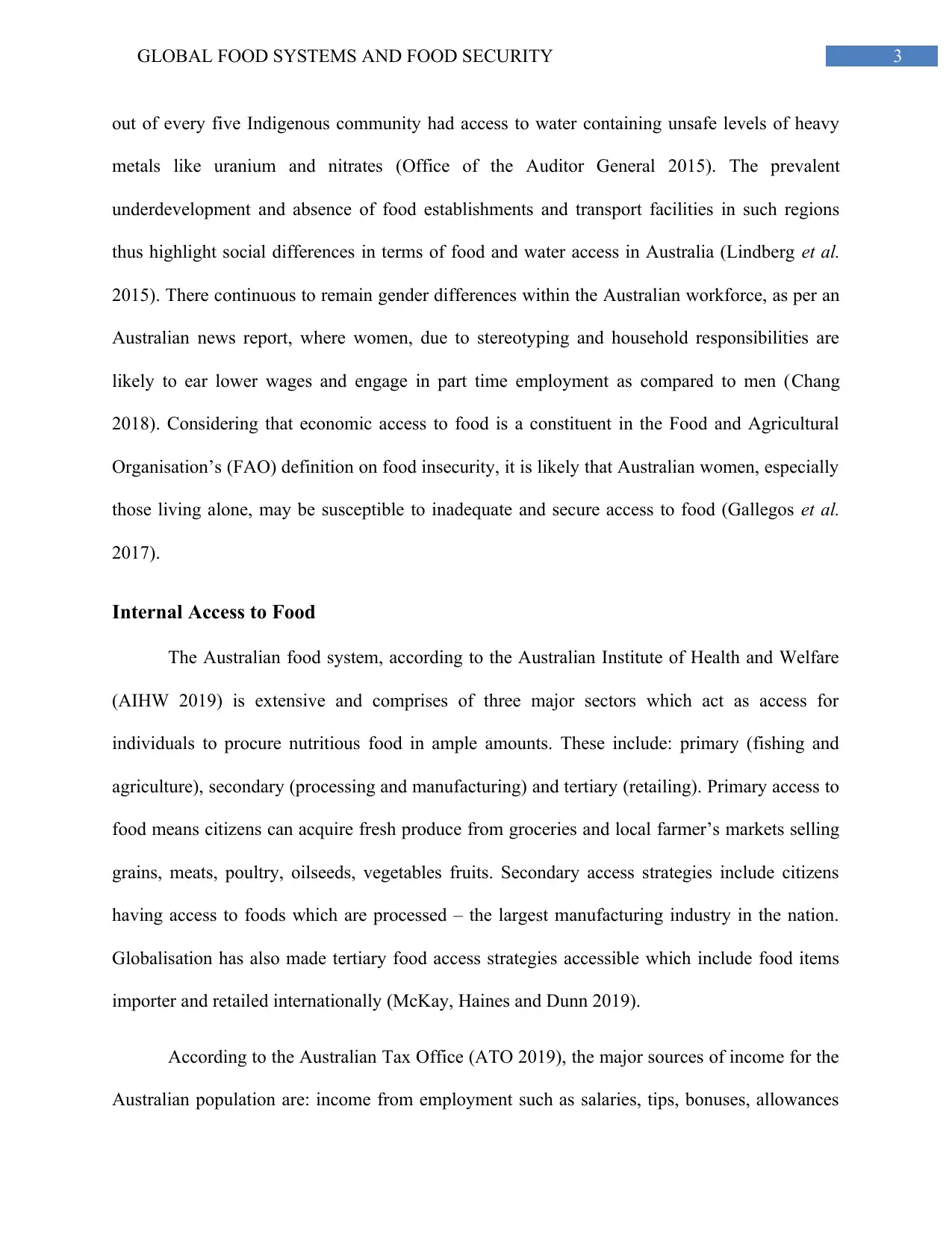
3GLOBAL FOOD SYSTEMS AND FOOD SECURITY
out of every five Indigenous community had access to water containing unsafe levels of heavy
metals like uranium and nitrates (Office of the Auditor General 2015). The prevalent
underdevelopment and absence of food establishments and transport facilities in such regions
thus highlight social differences in terms of food and water access in Australia (Lindberg et al.
2015). There continuous to remain gender differences within the Australian workforce, as per an
Australian news report, where women, due to stereotyping and household responsibilities are
likely to ear lower wages and engage in part time employment as compared to men (Chang
2018). Considering that economic access to food is a constituent in the Food and Agricultural
Organisation’s (FAO) definition on food insecurity, it is likely that Australian women, especially
those living alone, may be susceptible to inadequate and secure access to food (Gallegos et al.
2017).
Internal Access to Food
The Australian food system, according to the Australian Institute of Health and Welfare
(AIHW 2019) is extensive and comprises of three major sectors which act as access for
individuals to procure nutritious food in ample amounts. These include: primary (fishing and
agriculture), secondary (processing and manufacturing) and tertiary (retailing). Primary access to
food means citizens can acquire fresh produce from groceries and local farmer’s markets selling
grains, meats, poultry, oilseeds, vegetables fruits. Secondary access strategies include citizens
having access to foods which are processed – the largest manufacturing industry in the nation.
Globalisation has also made tertiary food access strategies accessible which include food items
importer and retailed internationally (McKay, Haines and Dunn 2019).
According to the Australian Tax Office (ATO 2019), the major sources of income for the
Australian population are: income from employment such as salaries, tips, bonuses, allowances
out of every five Indigenous community had access to water containing unsafe levels of heavy
metals like uranium and nitrates (Office of the Auditor General 2015). The prevalent
underdevelopment and absence of food establishments and transport facilities in such regions
thus highlight social differences in terms of food and water access in Australia (Lindberg et al.
2015). There continuous to remain gender differences within the Australian workforce, as per an
Australian news report, where women, due to stereotyping and household responsibilities are
likely to ear lower wages and engage in part time employment as compared to men (Chang
2018). Considering that economic access to food is a constituent in the Food and Agricultural
Organisation’s (FAO) definition on food insecurity, it is likely that Australian women, especially
those living alone, may be susceptible to inadequate and secure access to food (Gallegos et al.
2017).
Internal Access to Food
The Australian food system, according to the Australian Institute of Health and Welfare
(AIHW 2019) is extensive and comprises of three major sectors which act as access for
individuals to procure nutritious food in ample amounts. These include: primary (fishing and
agriculture), secondary (processing and manufacturing) and tertiary (retailing). Primary access to
food means citizens can acquire fresh produce from groceries and local farmer’s markets selling
grains, meats, poultry, oilseeds, vegetables fruits. Secondary access strategies include citizens
having access to foods which are processed – the largest manufacturing industry in the nation.
Globalisation has also made tertiary food access strategies accessible which include food items
importer and retailed internationally (McKay, Haines and Dunn 2019).
According to the Australian Tax Office (ATO 2019), the major sources of income for the
Australian population are: income from employment such as salaries, tips, bonuses, allowances
Paraphrase This Document
Need a fresh take? Get an instant paraphrase of this document with our AI Paraphraser
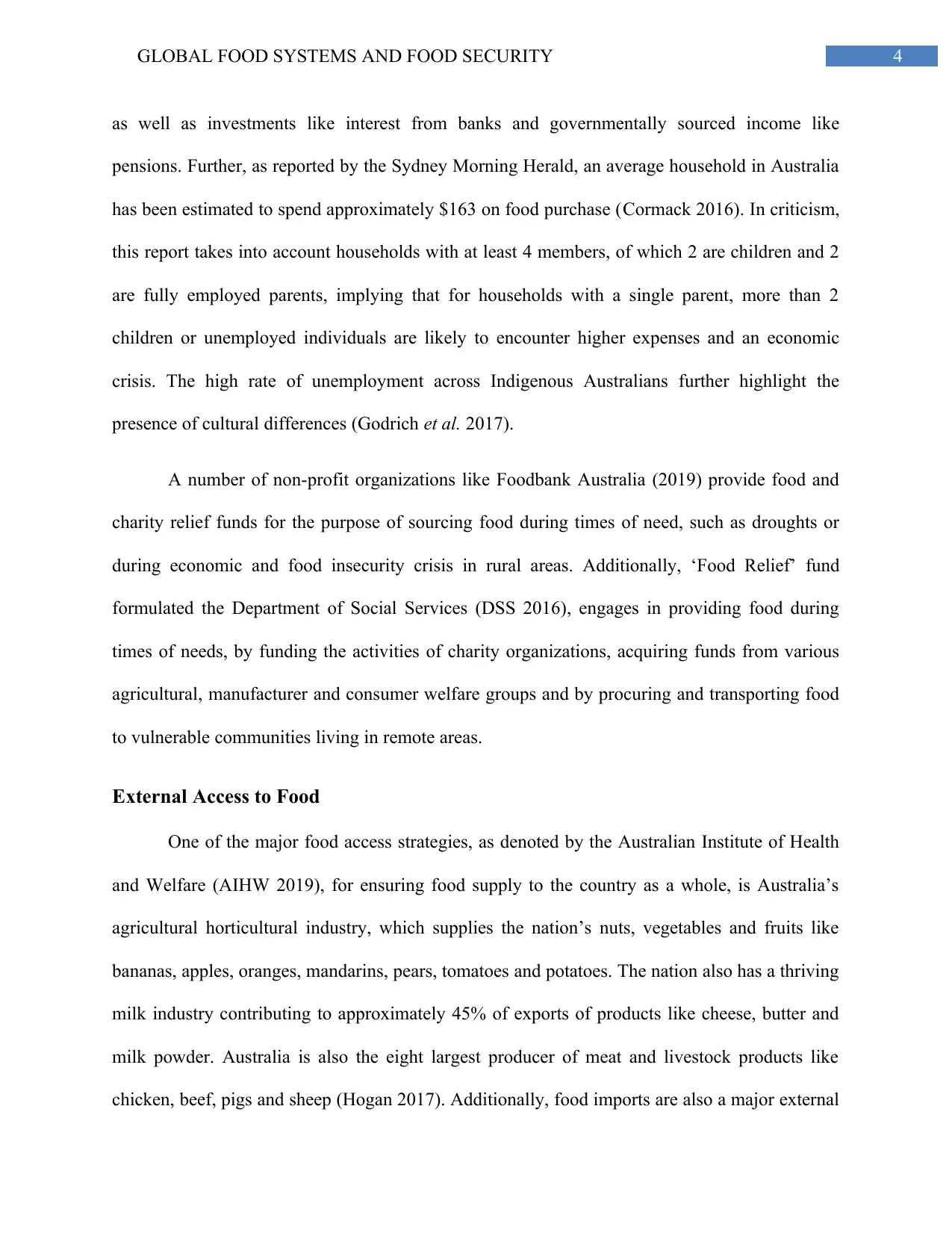
4GLOBAL FOOD SYSTEMS AND FOOD SECURITY
as well as investments like interest from banks and governmentally sourced income like
pensions. Further, as reported by the Sydney Morning Herald, an average household in Australia
has been estimated to spend approximately $163 on food purchase (Cormack 2016). In criticism,
this report takes into account households with at least 4 members, of which 2 are children and 2
are fully employed parents, implying that for households with a single parent, more than 2
children or unemployed individuals are likely to encounter higher expenses and an economic
crisis. The high rate of unemployment across Indigenous Australians further highlight the
presence of cultural differences (Godrich et al. 2017).
A number of non-profit organizations like Foodbank Australia (2019) provide food and
charity relief funds for the purpose of sourcing food during times of need, such as droughts or
during economic and food insecurity crisis in rural areas. Additionally, ‘Food Relief’ fund
formulated the Department of Social Services (DSS 2016), engages in providing food during
times of needs, by funding the activities of charity organizations, acquiring funds from various
agricultural, manufacturer and consumer welfare groups and by procuring and transporting food
to vulnerable communities living in remote areas.
External Access to Food
One of the major food access strategies, as denoted by the Australian Institute of Health
and Welfare (AIHW 2019), for ensuring food supply to the country as a whole, is Australia’s
agricultural horticultural industry, which supplies the nation’s nuts, vegetables and fruits like
bananas, apples, oranges, mandarins, pears, tomatoes and potatoes. The nation also has a thriving
milk industry contributing to approximately 45% of exports of products like cheese, butter and
milk powder. Australia is also the eight largest producer of meat and livestock products like
chicken, beef, pigs and sheep (Hogan 2017). Additionally, food imports are also a major external
as well as investments like interest from banks and governmentally sourced income like
pensions. Further, as reported by the Sydney Morning Herald, an average household in Australia
has been estimated to spend approximately $163 on food purchase (Cormack 2016). In criticism,
this report takes into account households with at least 4 members, of which 2 are children and 2
are fully employed parents, implying that for households with a single parent, more than 2
children or unemployed individuals are likely to encounter higher expenses and an economic
crisis. The high rate of unemployment across Indigenous Australians further highlight the
presence of cultural differences (Godrich et al. 2017).
A number of non-profit organizations like Foodbank Australia (2019) provide food and
charity relief funds for the purpose of sourcing food during times of need, such as droughts or
during economic and food insecurity crisis in rural areas. Additionally, ‘Food Relief’ fund
formulated the Department of Social Services (DSS 2016), engages in providing food during
times of needs, by funding the activities of charity organizations, acquiring funds from various
agricultural, manufacturer and consumer welfare groups and by procuring and transporting food
to vulnerable communities living in remote areas.
External Access to Food
One of the major food access strategies, as denoted by the Australian Institute of Health
and Welfare (AIHW 2019), for ensuring food supply to the country as a whole, is Australia’s
agricultural horticultural industry, which supplies the nation’s nuts, vegetables and fruits like
bananas, apples, oranges, mandarins, pears, tomatoes and potatoes. The nation also has a thriving
milk industry contributing to approximately 45% of exports of products like cheese, butter and
milk powder. Australia is also the eight largest producer of meat and livestock products like
chicken, beef, pigs and sheep (Hogan 2017). Additionally, food imports are also a major external
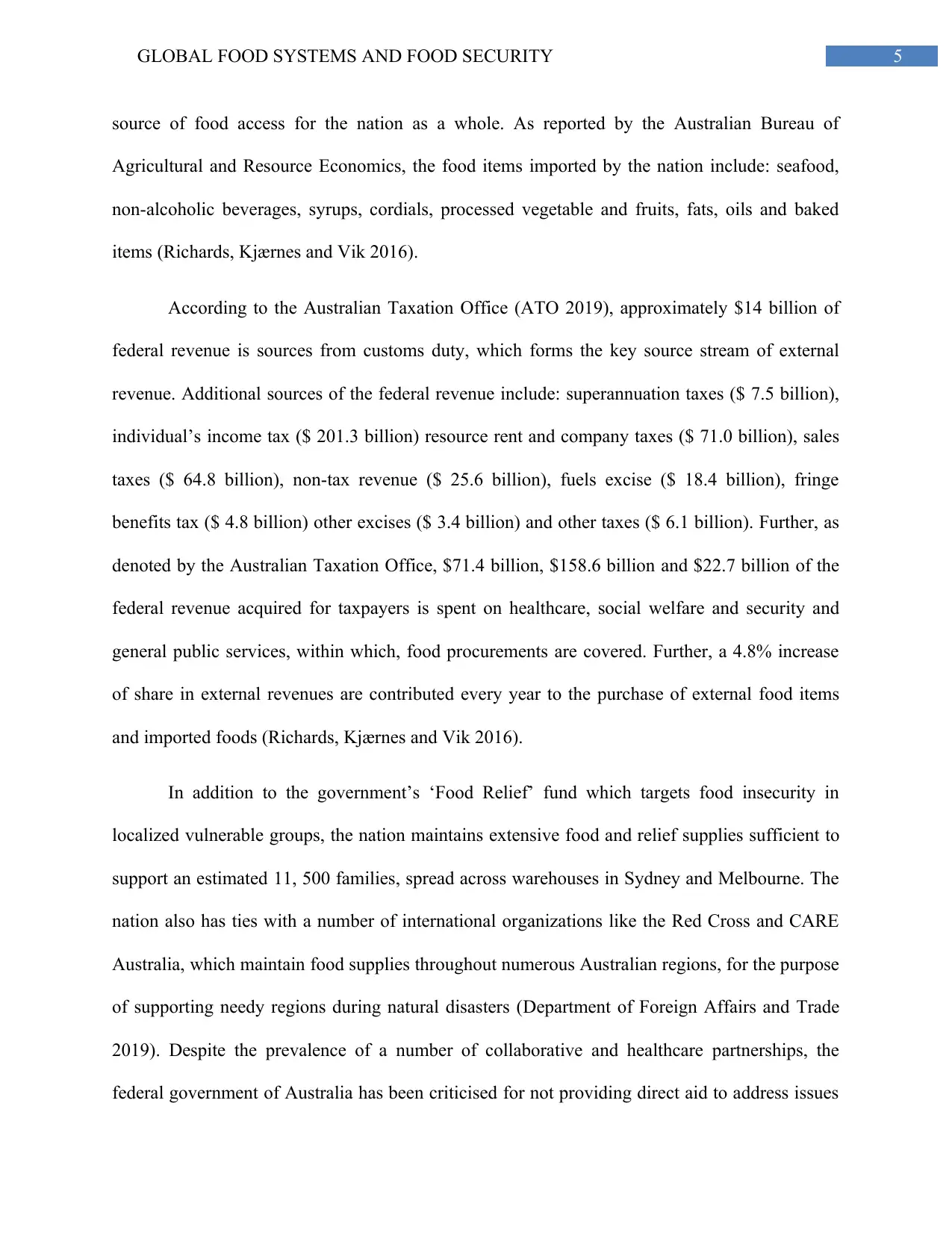
5GLOBAL FOOD SYSTEMS AND FOOD SECURITY
source of food access for the nation as a whole. As reported by the Australian Bureau of
Agricultural and Resource Economics, the food items imported by the nation include: seafood,
non-alcoholic beverages, syrups, cordials, processed vegetable and fruits, fats, oils and baked
items (Richards, Kjærnes and Vik 2016).
According to the Australian Taxation Office (ATO 2019), approximately $14 billion of
federal revenue is sources from customs duty, which forms the key source stream of external
revenue. Additional sources of the federal revenue include: superannuation taxes ($ 7.5 billion),
individual’s income tax ($ 201.3 billion) resource rent and company taxes ($ 71.0 billion), sales
taxes ($ 64.8 billion), non-tax revenue ($ 25.6 billion), fuels excise ($ 18.4 billion), fringe
benefits tax ($ 4.8 billion) other excises ($ 3.4 billion) and other taxes ($ 6.1 billion). Further, as
denoted by the Australian Taxation Office, $71.4 billion, $158.6 billion and $22.7 billion of the
federal revenue acquired for taxpayers is spent on healthcare, social welfare and security and
general public services, within which, food procurements are covered. Further, a 4.8% increase
of share in external revenues are contributed every year to the purchase of external food items
and imported foods (Richards, Kjærnes and Vik 2016).
In addition to the government’s ‘Food Relief’ fund which targets food insecurity in
localized vulnerable groups, the nation maintains extensive food and relief supplies sufficient to
support an estimated 11, 500 families, spread across warehouses in Sydney and Melbourne. The
nation also has ties with a number of international organizations like the Red Cross and CARE
Australia, which maintain food supplies throughout numerous Australian regions, for the purpose
of supporting needy regions during natural disasters (Department of Foreign Affairs and Trade
2019). Despite the prevalence of a number of collaborative and healthcare partnerships, the
federal government of Australia has been criticised for not providing direct aid to address issues
source of food access for the nation as a whole. As reported by the Australian Bureau of
Agricultural and Resource Economics, the food items imported by the nation include: seafood,
non-alcoholic beverages, syrups, cordials, processed vegetable and fruits, fats, oils and baked
items (Richards, Kjærnes and Vik 2016).
According to the Australian Taxation Office (ATO 2019), approximately $14 billion of
federal revenue is sources from customs duty, which forms the key source stream of external
revenue. Additional sources of the federal revenue include: superannuation taxes ($ 7.5 billion),
individual’s income tax ($ 201.3 billion) resource rent and company taxes ($ 71.0 billion), sales
taxes ($ 64.8 billion), non-tax revenue ($ 25.6 billion), fuels excise ($ 18.4 billion), fringe
benefits tax ($ 4.8 billion) other excises ($ 3.4 billion) and other taxes ($ 6.1 billion). Further, as
denoted by the Australian Taxation Office, $71.4 billion, $158.6 billion and $22.7 billion of the
federal revenue acquired for taxpayers is spent on healthcare, social welfare and security and
general public services, within which, food procurements are covered. Further, a 4.8% increase
of share in external revenues are contributed every year to the purchase of external food items
and imported foods (Richards, Kjærnes and Vik 2016).
In addition to the government’s ‘Food Relief’ fund which targets food insecurity in
localized vulnerable groups, the nation maintains extensive food and relief supplies sufficient to
support an estimated 11, 500 families, spread across warehouses in Sydney and Melbourne. The
nation also has ties with a number of international organizations like the Red Cross and CARE
Australia, which maintain food supplies throughout numerous Australian regions, for the purpose
of supporting needy regions during natural disasters (Department of Foreign Affairs and Trade
2019). Despite the prevalence of a number of collaborative and healthcare partnerships, the
federal government of Australia has been criticised for not providing direct aid to address issues
⊘ This is a preview!⊘
Do you want full access?
Subscribe today to unlock all pages.

Trusted by 1+ million students worldwide

6GLOBAL FOOD SYSTEMS AND FOOD SECURITY
of food insecurity resulting in the responsibility being completely burdened upon non-profit
organizations like the Salvation Army and Foodbank Australia. Such discrepancies in
governmental involvement must be addressed immediately to mitigate ongoing food crisis
prevalent in several regions of the nation (Kleve et al. 2017).
Internal Food Availability
The major share of Australia’s fruits are produced in areas like the Northern Territory and
Queensland whereas the erratic tropical and arid climates allow abundant growth of grains,
oilseeds and cereals like oats, barley, sorghum, canola, lentils, chickpeas and maize across
Victoria, New South Wales (NSW) and Tasmania (Worsley, Wang and Ridley 2015). Cattle and
grazing operations for meat and livestock production are prevalent across Tasmania, South
Western Australia, Victoria and NSW. Sydney and Melbourne house some of the largest food
warehousing facilities in the nation, which assist during both national as well as international
food supplies during times of need (Connell 2016).
The packaged and processed grocery retail industry is the largest in Australia, across
numerous urban areas in NSW, Queensland, Victoria, Tasmania, Western Australian, Norther
Territory and Australian Capital Territory (ACT), dealing with processing, packaging and
distribution infrastructure. Processed and packaged foods retailers and manufacturers are
distributed in Australia as follows: Independent Grocers of Australia (32%), Woolworths (20%),
Coles (17%), Foodworks (15%), ALDI (6%), Tasmanian Independent Retailers (5%) and SPAR
Australia (5%) (AIHW 2019).
of food insecurity resulting in the responsibility being completely burdened upon non-profit
organizations like the Salvation Army and Foodbank Australia. Such discrepancies in
governmental involvement must be addressed immediately to mitigate ongoing food crisis
prevalent in several regions of the nation (Kleve et al. 2017).
Internal Food Availability
The major share of Australia’s fruits are produced in areas like the Northern Territory and
Queensland whereas the erratic tropical and arid climates allow abundant growth of grains,
oilseeds and cereals like oats, barley, sorghum, canola, lentils, chickpeas and maize across
Victoria, New South Wales (NSW) and Tasmania (Worsley, Wang and Ridley 2015). Cattle and
grazing operations for meat and livestock production are prevalent across Tasmania, South
Western Australia, Victoria and NSW. Sydney and Melbourne house some of the largest food
warehousing facilities in the nation, which assist during both national as well as international
food supplies during times of need (Connell 2016).
The packaged and processed grocery retail industry is the largest in Australia, across
numerous urban areas in NSW, Queensland, Victoria, Tasmania, Western Australian, Norther
Territory and Australian Capital Territory (ACT), dealing with processing, packaging and
distribution infrastructure. Processed and packaged foods retailers and manufacturers are
distributed in Australia as follows: Independent Grocers of Australia (32%), Woolworths (20%),
Coles (17%), Foodworks (15%), ALDI (6%), Tasmanian Independent Retailers (5%) and SPAR
Australia (5%) (AIHW 2019).
Paraphrase This Document
Need a fresh take? Get an instant paraphrase of this document with our AI Paraphraser
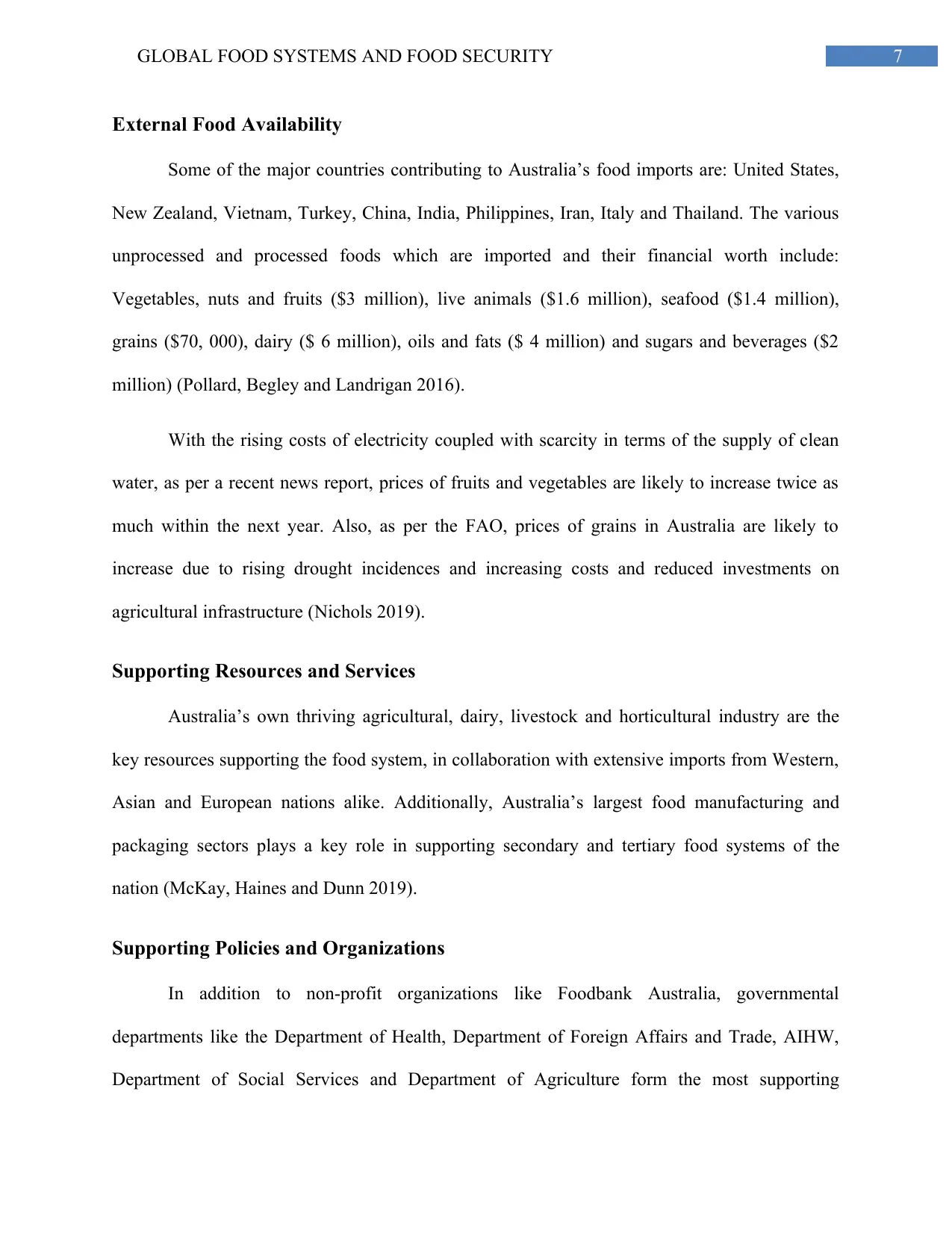
7GLOBAL FOOD SYSTEMS AND FOOD SECURITY
External Food Availability
Some of the major countries contributing to Australia’s food imports are: United States,
New Zealand, Vietnam, Turkey, China, India, Philippines, Iran, Italy and Thailand. The various
unprocessed and processed foods which are imported and their financial worth include:
Vegetables, nuts and fruits ($3 million), live animals ($1.6 million), seafood ($1.4 million),
grains ($70, 000), dairy ($ 6 million), oils and fats ($ 4 million) and sugars and beverages ($2
million) (Pollard, Begley and Landrigan 2016).
With the rising costs of electricity coupled with scarcity in terms of the supply of clean
water, as per a recent news report, prices of fruits and vegetables are likely to increase twice as
much within the next year. Also, as per the FAO, prices of grains in Australia are likely to
increase due to rising drought incidences and increasing costs and reduced investments on
agricultural infrastructure (Nichols 2019).
Supporting Resources and Services
Australia’s own thriving agricultural, dairy, livestock and horticultural industry are the
key resources supporting the food system, in collaboration with extensive imports from Western,
Asian and European nations alike. Additionally, Australia’s largest food manufacturing and
packaging sectors plays a key role in supporting secondary and tertiary food systems of the
nation (McKay, Haines and Dunn 2019).
Supporting Policies and Organizations
In addition to non-profit organizations like Foodbank Australia, governmental
departments like the Department of Health, Department of Foreign Affairs and Trade, AIHW,
Department of Social Services and Department of Agriculture form the most supporting
External Food Availability
Some of the major countries contributing to Australia’s food imports are: United States,
New Zealand, Vietnam, Turkey, China, India, Philippines, Iran, Italy and Thailand. The various
unprocessed and processed foods which are imported and their financial worth include:
Vegetables, nuts and fruits ($3 million), live animals ($1.6 million), seafood ($1.4 million),
grains ($70, 000), dairy ($ 6 million), oils and fats ($ 4 million) and sugars and beverages ($2
million) (Pollard, Begley and Landrigan 2016).
With the rising costs of electricity coupled with scarcity in terms of the supply of clean
water, as per a recent news report, prices of fruits and vegetables are likely to increase twice as
much within the next year. Also, as per the FAO, prices of grains in Australia are likely to
increase due to rising drought incidences and increasing costs and reduced investments on
agricultural infrastructure (Nichols 2019).
Supporting Resources and Services
Australia’s own thriving agricultural, dairy, livestock and horticultural industry are the
key resources supporting the food system, in collaboration with extensive imports from Western,
Asian and European nations alike. Additionally, Australia’s largest food manufacturing and
packaging sectors plays a key role in supporting secondary and tertiary food systems of the
nation (McKay, Haines and Dunn 2019).
Supporting Policies and Organizations
In addition to non-profit organizations like Foodbank Australia, governmental
departments like the Department of Health, Department of Foreign Affairs and Trade, AIHW,
Department of Social Services and Department of Agriculture form the most supporting
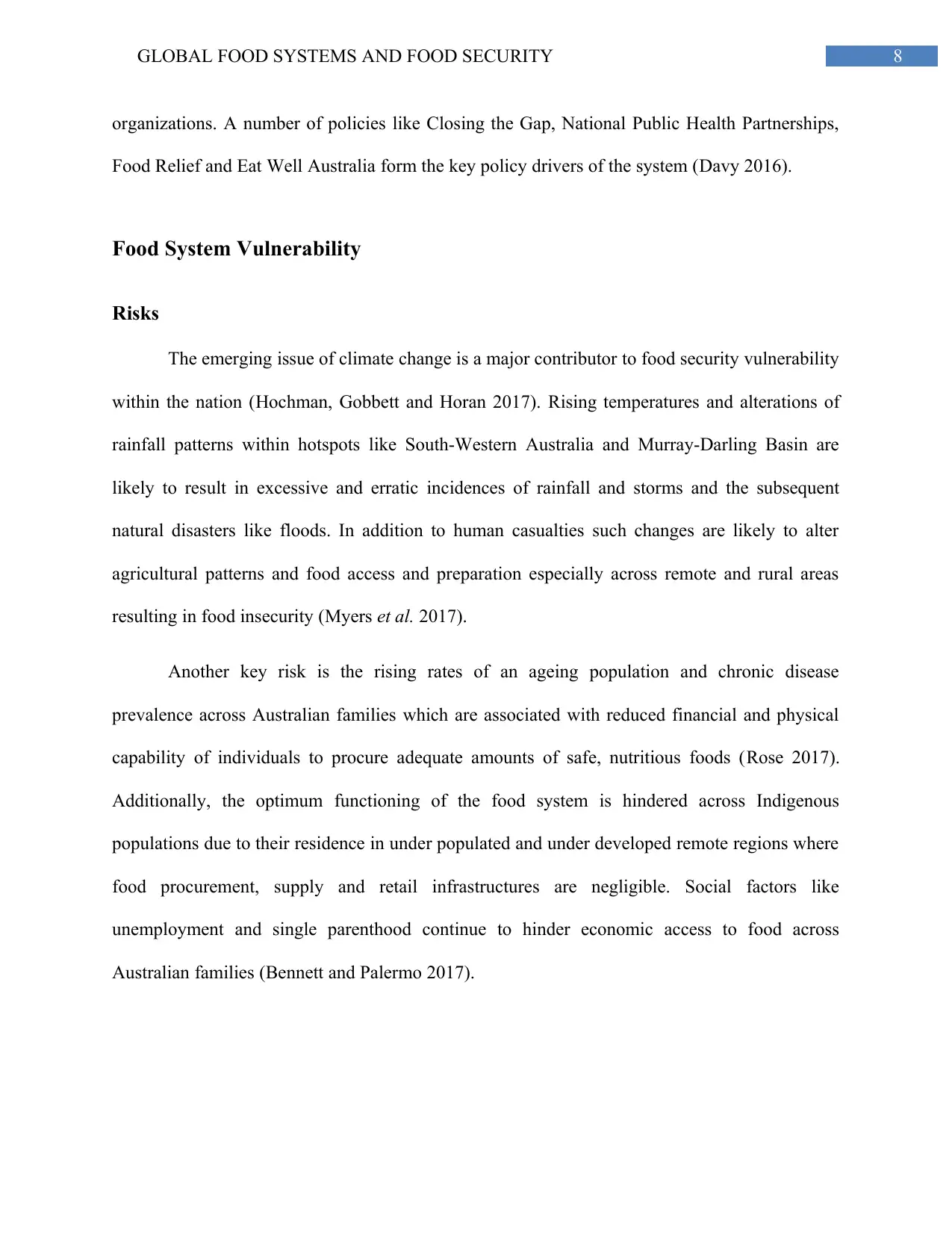
8GLOBAL FOOD SYSTEMS AND FOOD SECURITY
organizations. A number of policies like Closing the Gap, National Public Health Partnerships,
Food Relief and Eat Well Australia form the key policy drivers of the system (Davy 2016).
Food System Vulnerability
Risks
The emerging issue of climate change is a major contributor to food security vulnerability
within the nation (Hochman, Gobbett and Horan 2017). Rising temperatures and alterations of
rainfall patterns within hotspots like South-Western Australia and Murray-Darling Basin are
likely to result in excessive and erratic incidences of rainfall and storms and the subsequent
natural disasters like floods. In addition to human casualties such changes are likely to alter
agricultural patterns and food access and preparation especially across remote and rural areas
resulting in food insecurity (Myers et al. 2017).
Another key risk is the rising rates of an ageing population and chronic disease
prevalence across Australian families which are associated with reduced financial and physical
capability of individuals to procure adequate amounts of safe, nutritious foods (Rose 2017).
Additionally, the optimum functioning of the food system is hindered across Indigenous
populations due to their residence in under populated and under developed remote regions where
food procurement, supply and retail infrastructures are negligible. Social factors like
unemployment and single parenthood continue to hinder economic access to food across
Australian families (Bennett and Palermo 2017).
organizations. A number of policies like Closing the Gap, National Public Health Partnerships,
Food Relief and Eat Well Australia form the key policy drivers of the system (Davy 2016).
Food System Vulnerability
Risks
The emerging issue of climate change is a major contributor to food security vulnerability
within the nation (Hochman, Gobbett and Horan 2017). Rising temperatures and alterations of
rainfall patterns within hotspots like South-Western Australia and Murray-Darling Basin are
likely to result in excessive and erratic incidences of rainfall and storms and the subsequent
natural disasters like floods. In addition to human casualties such changes are likely to alter
agricultural patterns and food access and preparation especially across remote and rural areas
resulting in food insecurity (Myers et al. 2017).
Another key risk is the rising rates of an ageing population and chronic disease
prevalence across Australian families which are associated with reduced financial and physical
capability of individuals to procure adequate amounts of safe, nutritious foods (Rose 2017).
Additionally, the optimum functioning of the food system is hindered across Indigenous
populations due to their residence in under populated and under developed remote regions where
food procurement, supply and retail infrastructures are negligible. Social factors like
unemployment and single parenthood continue to hinder economic access to food across
Australian families (Bennett and Palermo 2017).
⊘ This is a preview!⊘
Do you want full access?
Subscribe today to unlock all pages.

Trusted by 1+ million students worldwide
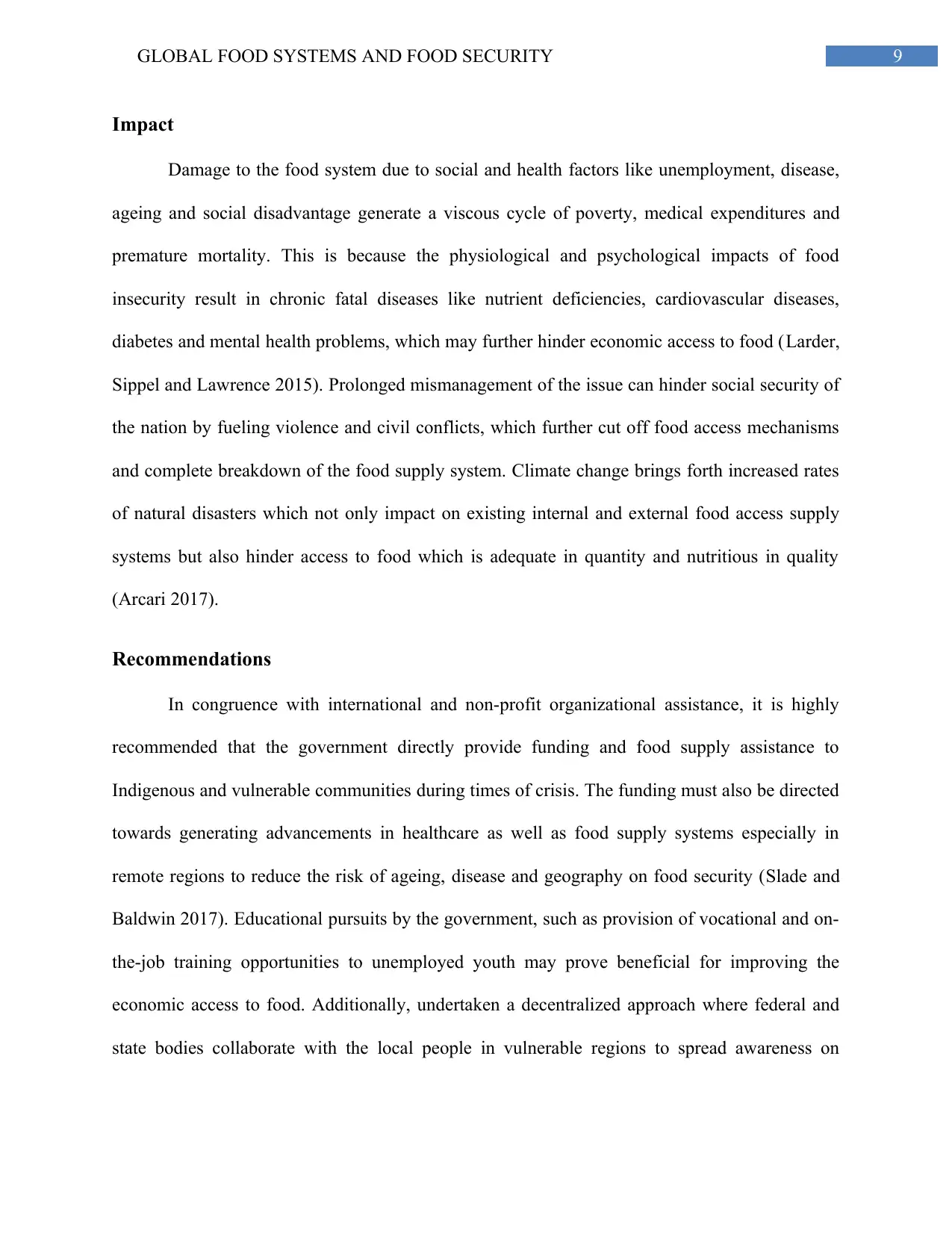
9GLOBAL FOOD SYSTEMS AND FOOD SECURITY
Impact
Damage to the food system due to social and health factors like unemployment, disease,
ageing and social disadvantage generate a viscous cycle of poverty, medical expenditures and
premature mortality. This is because the physiological and psychological impacts of food
insecurity result in chronic fatal diseases like nutrient deficiencies, cardiovascular diseases,
diabetes and mental health problems, which may further hinder economic access to food (Larder,
Sippel and Lawrence 2015). Prolonged mismanagement of the issue can hinder social security of
the nation by fueling violence and civil conflicts, which further cut off food access mechanisms
and complete breakdown of the food supply system. Climate change brings forth increased rates
of natural disasters which not only impact on existing internal and external food access supply
systems but also hinder access to food which is adequate in quantity and nutritious in quality
(Arcari 2017).
Recommendations
In congruence with international and non-profit organizational assistance, it is highly
recommended that the government directly provide funding and food supply assistance to
Indigenous and vulnerable communities during times of crisis. The funding must also be directed
towards generating advancements in healthcare as well as food supply systems especially in
remote regions to reduce the risk of ageing, disease and geography on food security (Slade and
Baldwin 2017). Educational pursuits by the government, such as provision of vocational and on-
the-job training opportunities to unemployed youth may prove beneficial for improving the
economic access to food. Additionally, undertaken a decentralized approach where federal and
state bodies collaborate with the local people in vulnerable regions to spread awareness on
Impact
Damage to the food system due to social and health factors like unemployment, disease,
ageing and social disadvantage generate a viscous cycle of poverty, medical expenditures and
premature mortality. This is because the physiological and psychological impacts of food
insecurity result in chronic fatal diseases like nutrient deficiencies, cardiovascular diseases,
diabetes and mental health problems, which may further hinder economic access to food (Larder,
Sippel and Lawrence 2015). Prolonged mismanagement of the issue can hinder social security of
the nation by fueling violence and civil conflicts, which further cut off food access mechanisms
and complete breakdown of the food supply system. Climate change brings forth increased rates
of natural disasters which not only impact on existing internal and external food access supply
systems but also hinder access to food which is adequate in quantity and nutritious in quality
(Arcari 2017).
Recommendations
In congruence with international and non-profit organizational assistance, it is highly
recommended that the government directly provide funding and food supply assistance to
Indigenous and vulnerable communities during times of crisis. The funding must also be directed
towards generating advancements in healthcare as well as food supply systems especially in
remote regions to reduce the risk of ageing, disease and geography on food security (Slade and
Baldwin 2017). Educational pursuits by the government, such as provision of vocational and on-
the-job training opportunities to unemployed youth may prove beneficial for improving the
economic access to food. Additionally, undertaken a decentralized approach where federal and
state bodies collaborate with the local people in vulnerable regions to spread awareness on
Paraphrase This Document
Need a fresh take? Get an instant paraphrase of this document with our AI Paraphraser
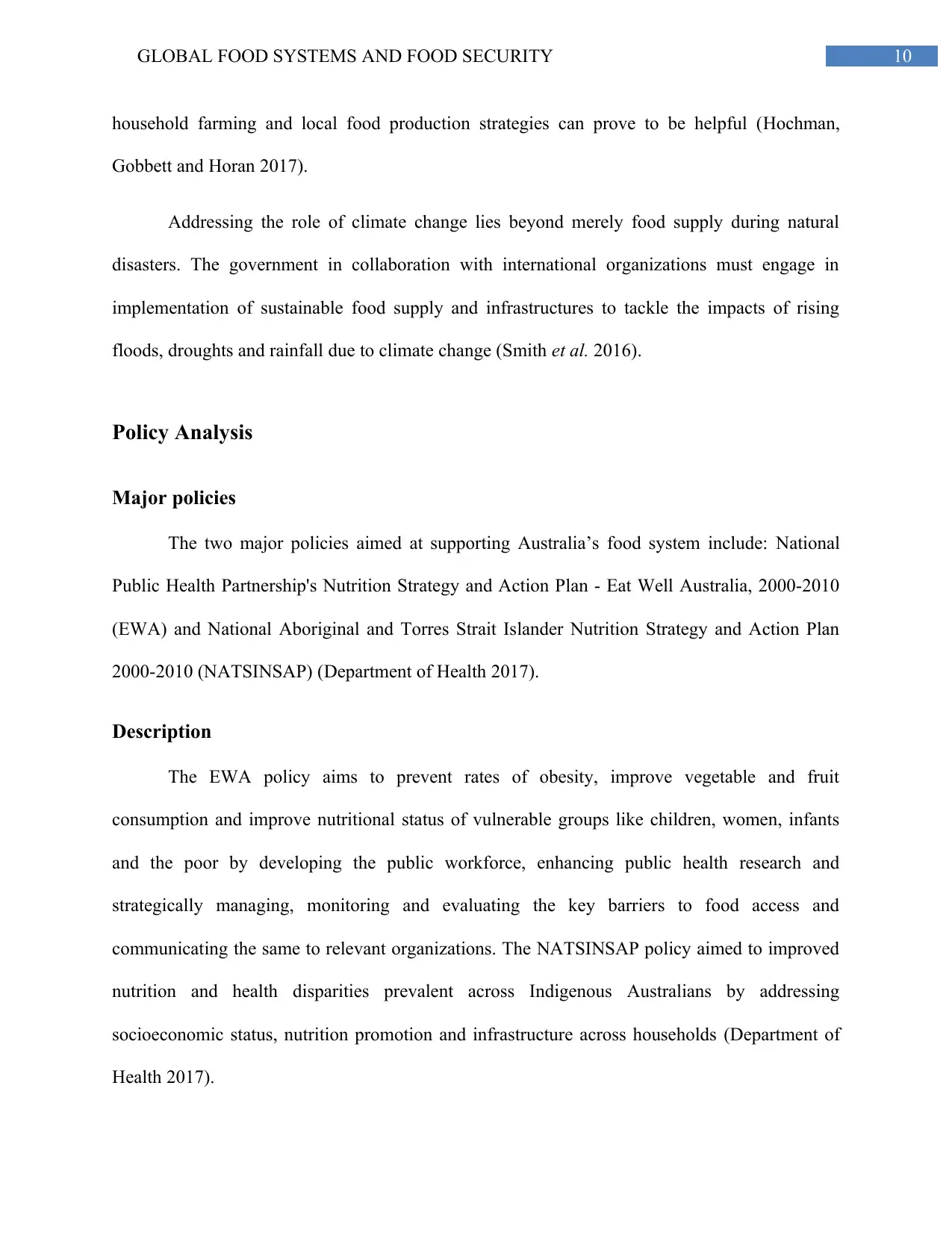
10GLOBAL FOOD SYSTEMS AND FOOD SECURITY
household farming and local food production strategies can prove to be helpful (Hochman,
Gobbett and Horan 2017).
Addressing the role of climate change lies beyond merely food supply during natural
disasters. The government in collaboration with international organizations must engage in
implementation of sustainable food supply and infrastructures to tackle the impacts of rising
floods, droughts and rainfall due to climate change (Smith et al. 2016).
Policy Analysis
Major policies
The two major policies aimed at supporting Australia’s food system include: National
Public Health Partnership's Nutrition Strategy and Action Plan - Eat Well Australia, 2000-2010
(EWA) and National Aboriginal and Torres Strait Islander Nutrition Strategy and Action Plan
2000-2010 (NATSINSAP) (Department of Health 2017).
Description
The EWA policy aims to prevent rates of obesity, improve vegetable and fruit
consumption and improve nutritional status of vulnerable groups like children, women, infants
and the poor by developing the public workforce, enhancing public health research and
strategically managing, monitoring and evaluating the key barriers to food access and
communicating the same to relevant organizations. The NATSINSAP policy aimed to improved
nutrition and health disparities prevalent across Indigenous Australians by addressing
socioeconomic status, nutrition promotion and infrastructure across households (Department of
Health 2017).
household farming and local food production strategies can prove to be helpful (Hochman,
Gobbett and Horan 2017).
Addressing the role of climate change lies beyond merely food supply during natural
disasters. The government in collaboration with international organizations must engage in
implementation of sustainable food supply and infrastructures to tackle the impacts of rising
floods, droughts and rainfall due to climate change (Smith et al. 2016).
Policy Analysis
Major policies
The two major policies aimed at supporting Australia’s food system include: National
Public Health Partnership's Nutrition Strategy and Action Plan - Eat Well Australia, 2000-2010
(EWA) and National Aboriginal and Torres Strait Islander Nutrition Strategy and Action Plan
2000-2010 (NATSINSAP) (Department of Health 2017).
Description
The EWA policy aims to prevent rates of obesity, improve vegetable and fruit
consumption and improve nutritional status of vulnerable groups like children, women, infants
and the poor by developing the public workforce, enhancing public health research and
strategically managing, monitoring and evaluating the key barriers to food access and
communicating the same to relevant organizations. The NATSINSAP policy aimed to improved
nutrition and health disparities prevalent across Indigenous Australians by addressing
socioeconomic status, nutrition promotion and infrastructure across households (Department of
Health 2017).
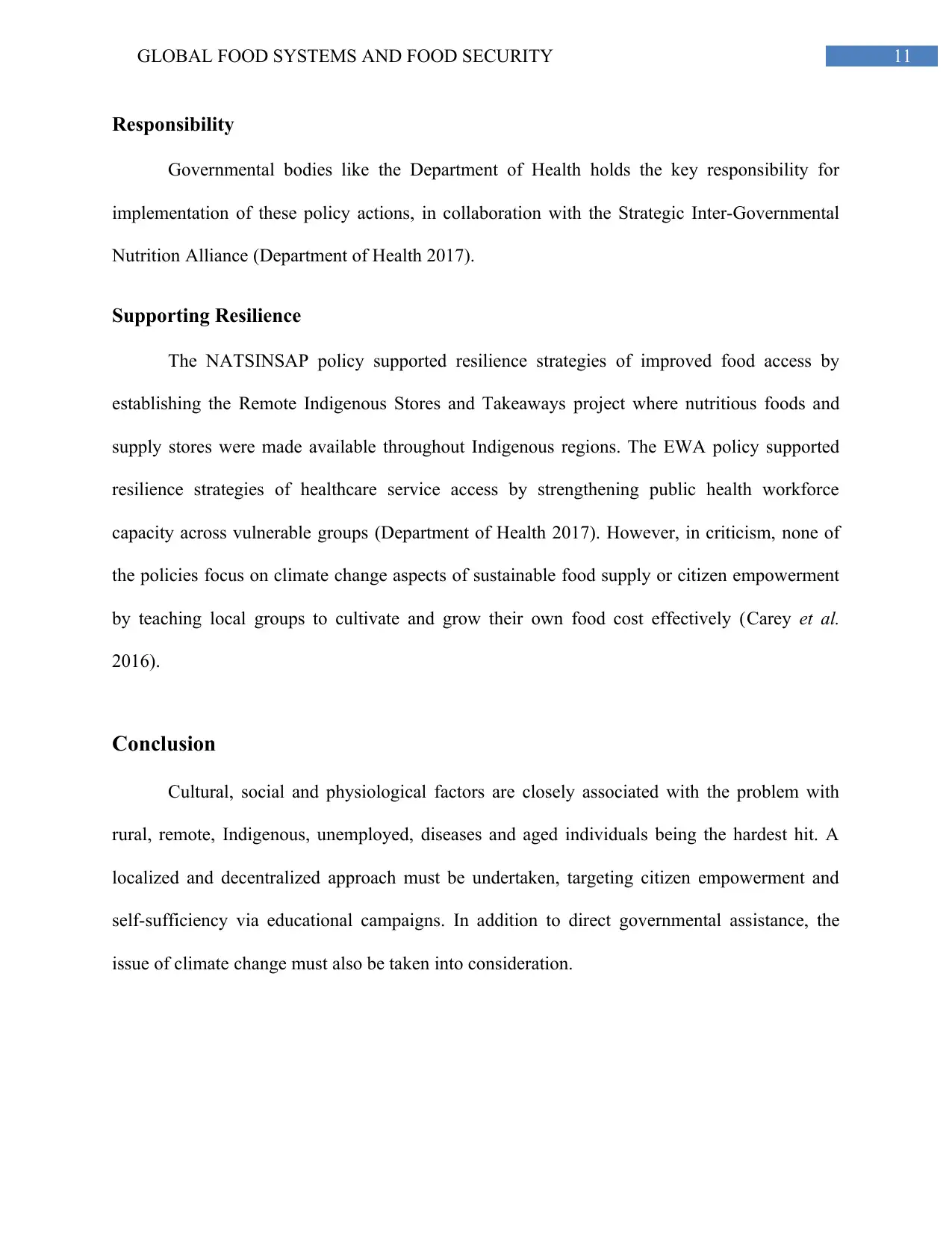
11GLOBAL FOOD SYSTEMS AND FOOD SECURITY
Responsibility
Governmental bodies like the Department of Health holds the key responsibility for
implementation of these policy actions, in collaboration with the Strategic Inter-Governmental
Nutrition Alliance (Department of Health 2017).
Supporting Resilience
The NATSINSAP policy supported resilience strategies of improved food access by
establishing the Remote Indigenous Stores and Takeaways project where nutritious foods and
supply stores were made available throughout Indigenous regions. The EWA policy supported
resilience strategies of healthcare service access by strengthening public health workforce
capacity across vulnerable groups (Department of Health 2017). However, in criticism, none of
the policies focus on climate change aspects of sustainable food supply or citizen empowerment
by teaching local groups to cultivate and grow their own food cost effectively (Carey et al.
2016).
Conclusion
Cultural, social and physiological factors are closely associated with the problem with
rural, remote, Indigenous, unemployed, diseases and aged individuals being the hardest hit. A
localized and decentralized approach must be undertaken, targeting citizen empowerment and
self-sufficiency via educational campaigns. In addition to direct governmental assistance, the
issue of climate change must also be taken into consideration.
Responsibility
Governmental bodies like the Department of Health holds the key responsibility for
implementation of these policy actions, in collaboration with the Strategic Inter-Governmental
Nutrition Alliance (Department of Health 2017).
Supporting Resilience
The NATSINSAP policy supported resilience strategies of improved food access by
establishing the Remote Indigenous Stores and Takeaways project where nutritious foods and
supply stores were made available throughout Indigenous regions. The EWA policy supported
resilience strategies of healthcare service access by strengthening public health workforce
capacity across vulnerable groups (Department of Health 2017). However, in criticism, none of
the policies focus on climate change aspects of sustainable food supply or citizen empowerment
by teaching local groups to cultivate and grow their own food cost effectively (Carey et al.
2016).
Conclusion
Cultural, social and physiological factors are closely associated with the problem with
rural, remote, Indigenous, unemployed, diseases and aged individuals being the hardest hit. A
localized and decentralized approach must be undertaken, targeting citizen empowerment and
self-sufficiency via educational campaigns. In addition to direct governmental assistance, the
issue of climate change must also be taken into consideration.
⊘ This is a preview!⊘
Do you want full access?
Subscribe today to unlock all pages.

Trusted by 1+ million students worldwide
1 out of 19
Your All-in-One AI-Powered Toolkit for Academic Success.
+13062052269
info@desklib.com
Available 24*7 on WhatsApp / Email
![[object Object]](/_next/static/media/star-bottom.7253800d.svg)
Unlock your academic potential
Copyright © 2020–2025 A2Z Services. All Rights Reserved. Developed and managed by ZUCOL.


